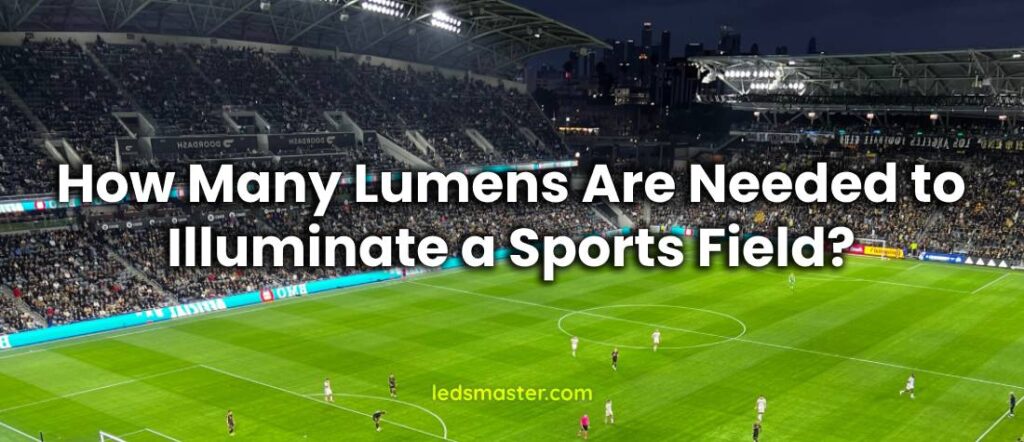Table of Contents
ToggleIntroduction
More and more people are now participating in nighttime sports activities on fields and in stadiums. This trend underscores the need for effective illumination of various sports fields, whether for recreational or professional purposes. Proper lighting with adequate lumens ensures athletes can clearly see their surroundings and the ball.
The key question remains: How many lumens are necessary to light sports fields like football fields, cricket grounds, baseball diamonds, basketball courts, or tennis courts? What constitutes the minimum lumens required for optimal sports field illumination? This article aims to address these important questions.
What Lumen Output is Ideal for Sports Stadium Lighting?
Lumens are a crucial metric for measuring brightness, particularly in sports lighting. To provide a simple analogy, 1 lumen is roughly equivalent to the brightness of a candle. In the context of stadium floodlights, lumens serve as a measure of their light output, analogous to horsepower in an engine.
Lumens vs Lux
Understanding the distinctions between lumens and lux is essential for effectively designing and evaluating stadium lighting systems. While both metrics are fundamental to assessing light, they serve distinct purposes in the context of sports field illumination.
Lumens represent the total amount of visible light emitted by a light source in all directions. This measurement characterizes the intrinsic brightness of the source itself, providing a standardized unit to compare different light fixtures or bulbs. In stadium lighting, lumens help determine the initial light output potential of floodlights or other luminaires installed to illuminate sports fields. However, lumens alone do not account for factors such as distance from the light source or how the light spreads and diminishes as it travels.
Lux, on the other hand, measures illuminance, which specifically quantifies the amount of light that reaches a surface. In the context of sports fields, lux indicates the intensity of light experienced on the horizontal plane of the playing area. It takes into consideration variables such as the distance from the light source, the angle of illumination, and any obstructions that may affect light transmission. Lux values are crucial for ensuring adequate and uniform illumination across the field, directly impacting visibility for athletes and spectators alike.
Practically, the relationship between lumens and lux illustrates the transformation from light emission to light reception. While lumens define the potential light output from a fixture, lux measures the practical impact of that light on the playing surface. Notably, the lux value decreases as the distance from the light source increases due to light spreading and attenuation. Thus, placing a lux meter at strategic points on the sports field allows designers to assess how effectively light is distributed and whether minimum illuminance requirements for specific sports activities are met. This understanding enables precise adjustments in lighting layouts to optimize performance outcomes, enhance visual clarity, and ensure energy efficiency in stadium environments.
Football Field and Soccer Field
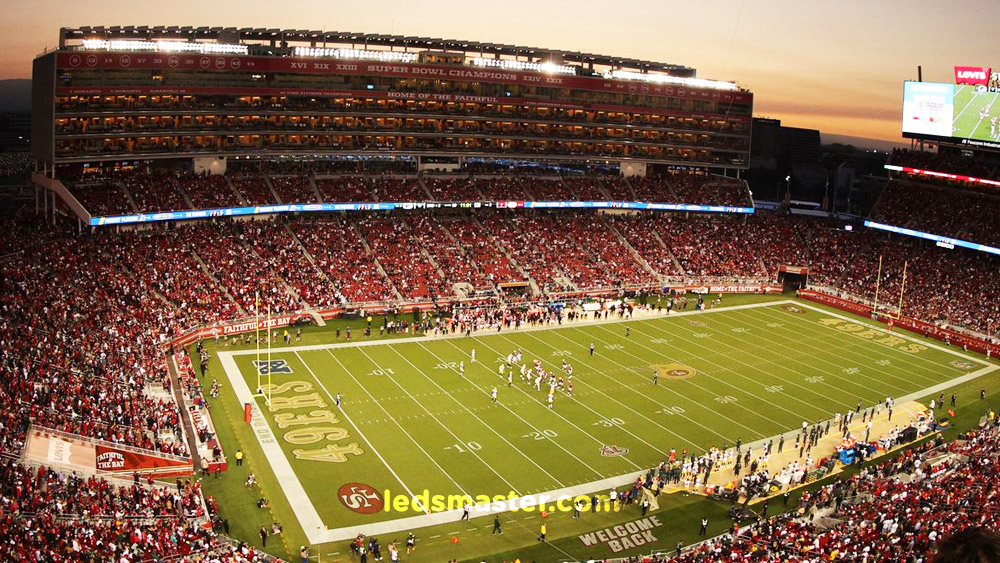
Illuminating a football or soccer field effectively requires careful consideration of various factors that influence the lumen requirements. The size of the field plays a crucial role, with football fields typically ranging from 90 to 120 meters in length and 45 to 90 meters in width, while soccer fields are generally smaller but still significant in size. The larger the field, the more lumens are needed to ensure uniform illumination across the entire playing surface, from the sidelines to the penalty areas. Lighting designs must account for the specific dimensions of the field, aiming to minimize shadows and provide optimal visibility for players, referees, and spectators alike.
The lumen requirements can vary significantly based on the intended use of the stadium. For professional competitions and high-profile matches, where precision and visibility are critical, lighting systems often exceed 10 million lumens. These high-output systems are designed to meet stringent lighting standards set by international sports federations, ensuring that the playing conditions are optimal for performance and safety. The placement and orientation of lighting fixtures also play a key role in achieving the desired lighting levels, with strategically positioned floodlights or LED fixtures used to evenly distribute light across the field without causing glare or light spillage.
Moreover, advancements in lighting technology, such as LED fixtures, have revolutionized sports field lighting by offering improved energy efficiency, durability, and control over light distribution. LED lights can be precisely adjusted to meet specific lighting requirements, allowing stadiums to achieve high lumen outputs while minimizing energy consumption and maintenance costs over time. This combination of technology and meticulous planning ensures that football and soccer fields are adequately illuminated to meet the rigorous demands of modern sports competitions, enhancing the overall experience for athletes and spectators alike.
| Type of Football Field | Football Field and Soccer Field Lighting Lumen |
| Recreational football field | 2,200,000 to 3,000,000 lumens |
| Amateur competition or training soccer field | 4,000,000 to 8,000,000 lumens |
| High school football stadium | 10,000,000 to 15,000,000 lumens |
| Stadium for national & international 4K broadcasting | 22,500,000 to 40,000,000 lumens |
Cricket Field
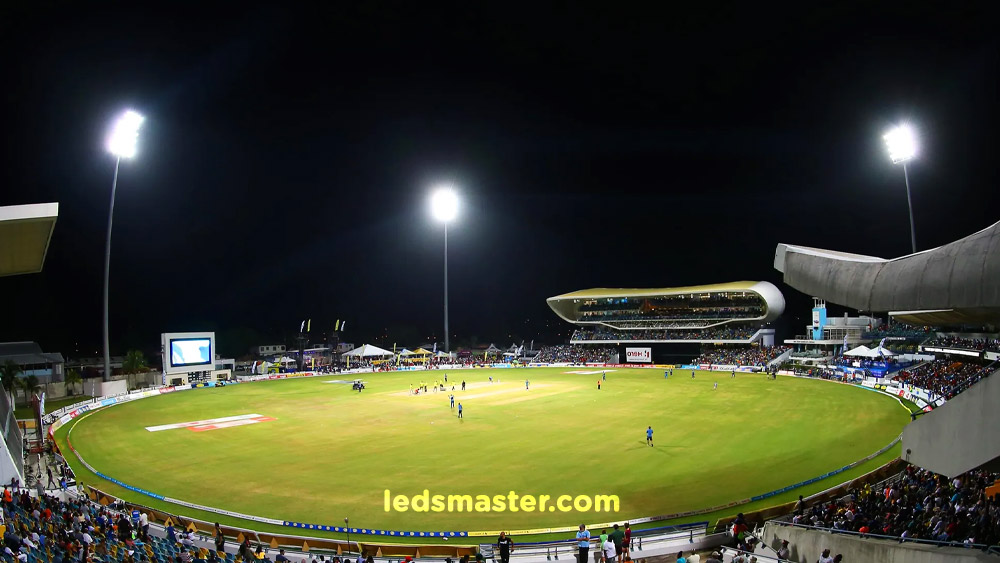
Cricket pitches and soccer pitches indeed exhibit notable differences in size and lighting requirements, necessitating distinct approaches to meet their respective illumination needs. A standard cricket field typically spans between 135 to 155 meters in diameter, depending on the specific regulations and dimensions set by cricketing authorities. This expansive area requires sufficient lumen output to ensure clear visibility of the pitch for players and officials alike. Lighting design for cricket fields must account for the need to evenly illuminate the playing surface, ensuring minimal shadows and optimal visibility of the ball under varying weather conditions and times of day.
On the other hand, soccer pitches vary in size but are generally more compact compared to cricket fields, with dimensions that typically range between 90 to 120 meters in length and 45 to 90 meters in width. The smaller size of soccer pitches necessitates a focused approach to lighting design to ensure consistent light distribution across the field. Effective illumination is crucial to support players’ ability to navigate and perform effectively during matches, requiring precise calculations of lumen output to meet the sport’s rigorous standards and regulations.
In both cases, the calculation of necessary lumens for sports field lighting involves considerations beyond just the size of the playing area. Factors such as the type and positioning of lighting fixtures, the height at which they are installed, and the angles of illumination all play critical roles in determining the overall quality and effectiveness of the lighting solution. Additionally, adherence to international lighting standards ensures that the lighting design enhances visibility, reduces glare, and contributes to the safety and enjoyment of players and spectators alike during sports events held under artificial lighting conditions.
| Type of Cricket Field | Lumens for Cricket Field |
| Class I (International cricket matches) | 15,000,000 to 30,000,000 lumens |
| Class II (High school or regional competitions) | 7,500,000 to 12,000,000 lumens |
| Class III (Amateur or recreational cricket ground) | 2,500,000 to 6,000,000 lumens |
| Indoor cricket practice net | 2,000,000 to 4,500,000 lumens |
The lumen requirement for indoor cricket pitches is generally lower since intense lighting isn’t essential for training purposes. However, for international cricket matches such as those organized by ICC, up to 30 million lumens of lighting may be necessary for optimal visibility.
Baseball Field
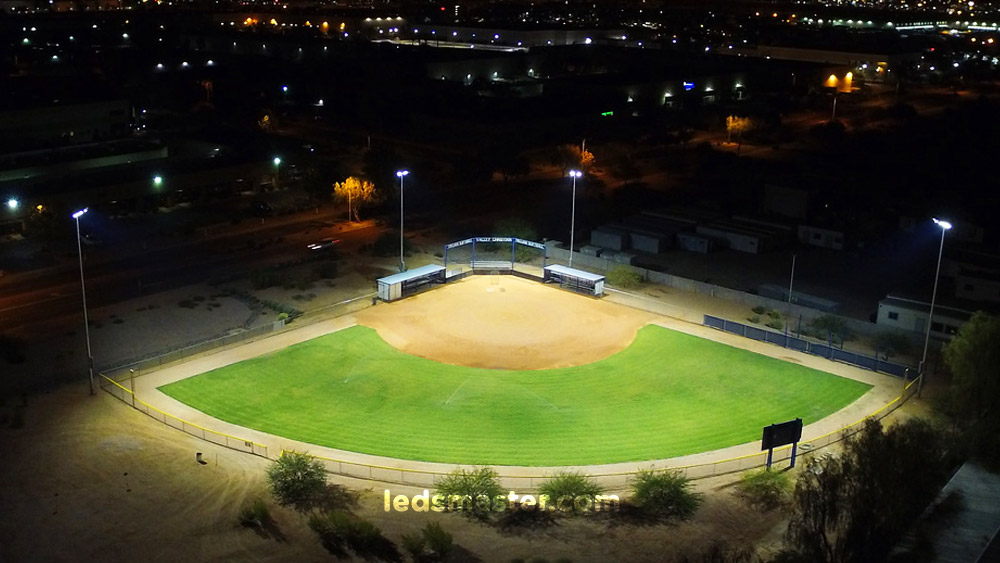
Determining the necessary lumens to effectively illuminate a baseball field, which typically spans a radius of 80 to 120 meters (260 to 400 feet), involves strategic planning and calculation. The primary objective of stadium lighting is to provide sufficient brightness across the entire playing area, ensuring optimal visibility for players, officials, and spectators alike. This requires careful consideration of light distribution to minimize glare, shadows, and uneven lighting that could impact gameplay.
Key factors influencing the calculation of lumens include the size and layout of the field, the mounting height and placement of lighting fixtures, and the type of light sources used. Designers must also adhere to lighting standards and regulations to meet safety requirements and provide a comfortable viewing experience for spectators.
| Type of Baseball Field | Baseball Field Lighting Lumens |
| Recreational baseball diamond | 800,000 to 2,500,000 lumens |
| Baseball field for high school or regional competitions | 5,000,000 to 8,000,000 lumens |
| Professional baseball stadium | 10,000,000 to 15,000,000 lumens |
This guideline provides a foundational starting point for determining the appropriate lumen output needed to effectively illuminate a baseball field. It acknowledges that the size and scale of the field directly influence the amount of light required to achieve optimal visibility. Larger baseball fields, which encompass more extensive playing areas from the pitcher’s mound to the outfield, necessitate a proportional increase in lumens to ensure uniform brightness across all sections of the field.
The proportional increase in required lumens for larger baseball fields underscores the importance of precision in lighting design. Designers must account not only for the field’s dimensions but also for factors such as the height and placement of lighting fixtures, the type of lighting technology used, and the desired lighting levels. This approach ensures that players have clear visibility of the ball and surrounding areas, essential for gameplay, while also providing spectators with a comfortable viewing experience.
Tennis Court
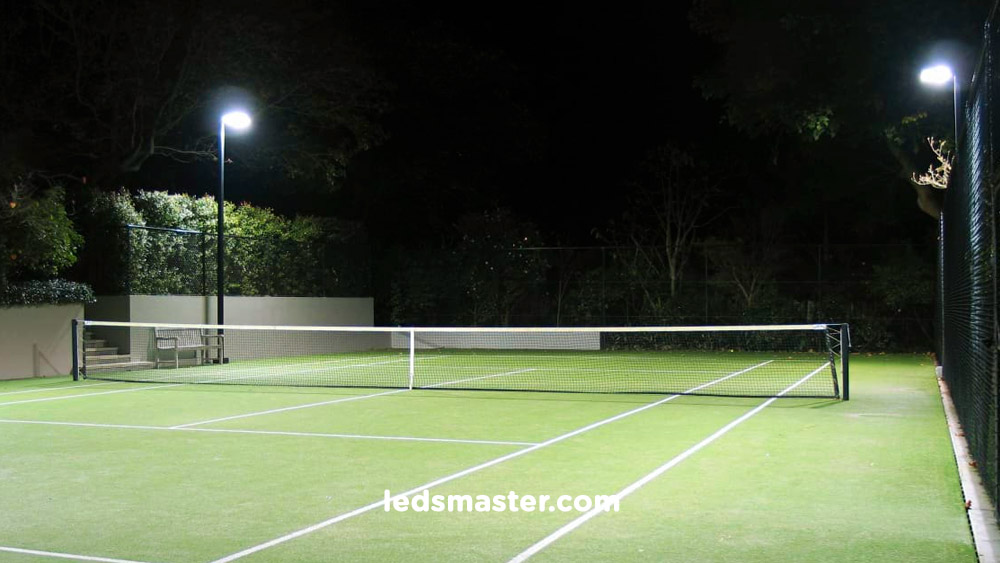
Tennis is widely enjoyed as a nighttime sport, necessitating proper lighting to facilitate gameplay and ensure safety. Unlike expansive soccer or cricket fields, tennis courts are comparatively compact in size. This difference in scale directly influences the lighting requirements, as smaller areas require fewer lumens to achieve adequate brightness and visibility across the entire court surface.
Efficient lighting design for tennis courts focuses on evenly distributing light to eliminate shadows and provide clear visibility of the ball and court boundaries. Lower lumen requirements for tennis court lighting also reflect the need to minimize light spillage and glare, which can affect players’ concentration and performance.
Advanced lighting technologies, such as LED fixtures, offer precise control over light distribution and intensity, enhancing energy efficiency while meeting the specific lighting standards for tennis courts. This ensures that players can comfortably and effectively engage in matches during evening hours, maintaining the sport’s competitive spirit and enjoyment for participants and spectators alike.
| Type of Tennis Court | How Many Lumens Does a Tennis Court Need? |
| Class I (Professional, international tournaments) | 500,000 to 1,200,000 lumens |
| Class II (Regional competition) | 400,000 to 800,000 lumens |
| Class III (Amateur or training) | 110,000 to 250,000 lumens |
Common tennis court lighting setups often require a lumen output spanning from 110,000 to 1,200,000 lumens, depending on the specific size and layout of the court. Achieving this level of brightness typically involves employing LED fixtures that consume between 1000 to 1500 watts of power. This choice of technology not only ensures sufficient illumination but also enhances energy efficiency compared to traditional lighting sources.
To achieve effective lighting on a tennis court, precise planning of the light pole height and their spacing is crucial. Optimal positioning helps to evenly distribute light across the playing area, minimizing shadows and ensuring clear visibility of the court surface and ball trajectory. The height of the light poles and the distance between them are meticulously calculated to create a balanced lighting design that meets international standards for tennis court illumination.
Furthermore, modern LED lighting solutions offer advantages such as instant brightness, reliability, and durability, making them ideal for sports environments where consistent and high-quality lighting is essential. These fixtures can be tailored to provide directional lighting that reduces light spillage and glare, thus optimizing playing conditions for athletes and enhancing the overall experience for spectators.
Basketball Court
Just as with tennis courts, basketball courts are typically smaller in size compared to larger sports venues, which means they require a proportional amount of lighting to ensure adequate visibility. The lighting requirements for a standard basketball court are generally lower compared to larger arenas or stadiums used for professional leagues like the NBA.
Efficient lighting design for basketball courts focuses on achieving uniform illumination across the playing surface, including the key areas such as the court boundaries, hoops, and surrounding areas. This ensures that players have clear visibility of the ball and can navigate the court effectively during games played in the evening or at night.
While smaller basketball courts may not require the same high lumen outputs as larger arenas, such as those used for professional NBA games, precision in lighting placement and technology remains crucial. Utilizing modern LED fixtures allows for customizable lighting solutions that minimize energy consumption while optimizing brightness and reducing glare. This approach not only enhances the playing experience for athletes but also provides spectators with a clear view of the action, maintaining the excitement and competitiveness of basketball games held in indoor or outdoor settings.
| Type of Basketball Court | Basketball Court Lighting Lumen Required |
| Amateur level or recreational basketball court | 150,000 to 250,000 lumens |
| Domestic basketball competition | 300,000 to 500,000 lumens |
| Professional level (TV broadcasting, NBA, etc) | 650,000 to 2,000,000 lumens |
The lighting requirements for basketball courts differ based on the level of competition and the specific standards set for each type of court. Recreational basketball courts typically require between 150,000 to 250,000 lumens to adequately illuminate the playing area. This level of lighting ensures that players have sufficient visibility to navigate the court, track the ball, and execute plays effectively during casual or amateur games.
In contrast, NBA basketball courts demand much higher lumen outputs, often reaching up to 2,000,000 lumens. This intense lighting is essential to meet the rigorous standards of professional basketball games. NBA-level lighting designs prioritize uniformity across the entire court, ensuring there are minimal shadows, glare, or flicker that could affect players’ performance or visibility. The lighting must also be anti-glare to enhance visibility for both players and spectators while maintaining a clear and consistent illumination that meets broadcast standards.
Achieving these high standards involves careful planning of lighting fixture placement, height, and distribution to achieve optimal light coverage without compromising on energy efficiency or visual comfort. Modern lighting technologies, such as LED fixtures, offer precise control over light intensity and direction, allowing for customizable solutions that meet the specific requirements of basketball courts at all levels of competition. This approach not only enhances the playing experience but also contributes to the overall ambiance and excitement of basketball games held in indoor arenas or outdoor courts.
Volleyball Court
Based on our practical experience, determining the appropriate lighting for a volleyball or beach volleyball court involves considering several factors, particularly the level of competition being hosted. For recreational or amateur courts, a lower lumen range of approximately 15,000 to 50,000 lumens may suffice to ensure adequate visibility for players and spectators. This level of lighting is typically suitable for casual games and training sessions where precise lighting conditions are less critical.
On the other hand, professional or high-level competition courts require higher lumen outputs ranging from 100,000 to 200,000 lumens or more. This ensures that the playing area is uniformly and brightly illuminated, facilitating optimal performance by players. The lighting design for these courts must also minimize glare and shadows to enhance visibility of the ball and player movements, crucial for competitive play.
Modern lighting technologies such as LED fixtures are often preferred for volleyball courts due to their ability to provide high lumen outputs while maintaining energy efficiency and durability. Strategic placement of these fixtures, along with considerations for fixture height and light distribution, plays a pivotal role in achieving the desired lighting levels and quality across the court. This approach not only enhances gameplay conditions but also contributes to the overall spectator experience, ensuring that all aspects of the volleyball match are clearly visible and enjoyable.
| Type of Volleyball Court | What Are the Lumens for Volleyball Court Lighting? |
| Recreational, community beach volleyball court | 15,000 to 40,000 lumens |
| Volleyball court for regional competition | 46,000 to 80,000 lumens |
| Professional | 120,000 to 200,000 lumens |
Ensuring adequate lighting for a volleyball court is crucial to support players in following the trajectory of the ball, which moves swiftly during matches. Shadow-free illumination is particularly important in volleyball to maintain consistent visibility across the entire playing area. Shadows can disrupt players’ ability to anticipate ball movements and react quickly, potentially impacting the flow of the game and player performance.
A well-designed volleyball court lighting system typically incorporates multiple poles (often 4 or 6) strategically positioned around the court perimeter. This layout helps to evenly distribute light and minimize shadows that could be cast by players or equipment. By reducing shadows, the lighting design enhances visibility and clarity, allowing players to maintain optimal focus and precision during serves, passes, and spikes.
Modern lighting technologies, such as LED fixtures, offer advantages in achieving shadow-free illumination while also optimizing energy efficiency and durability. These fixtures can be precisely adjusted to control light direction and intensity, ensuring that the entire volleyball court is well-lit without causing glare or uneven lighting. Such thoughtful lighting design not only enhances gameplay conditions but also contributes to the overall experience for both players and spectators, fostering an environment conducive to competitive and enjoyable volleyball matches.
Hockey Rink and Ice Rink
Field hockey and ice hockey have become increasingly popular sports, attracting more participants to play these dynamic and fast-paced games indoors or outdoors. LED lighting has emerged as the preferred choice for illuminating these venues due to its ability to provide high lumen outputs without generating excessive heat. This feature is critical for maintaining the integrity of the ice surface in hockey rinks and preventing potential melting that could disrupt gameplay.
To achieve optimal lighting conditions for a field hockey rink, it is crucial to maintain illumination levels ranging from 250 lux to 750 lux. This corresponds to a lumen requirement of approximately 400,000 to 1,200,000 lumens, depending on the size and layout of the rink. Consistent and evenly distributed lighting across the playing area is essential to enhance visibility for players, referees, and spectators, facilitating smooth gameplay and accurate assessment of game actions.
LED lighting technology offers several advantages, including energy efficiency and heat management. It allows for precise control over light direction and intensity, enabling customized lighting solutions that reduce glare and shadows on the playing surface. Such considerations are vital for ensuring safe and competitive conditions during field hockey and ice hockey matches, enabling players to perform at their best while providing spectators with an enhanced viewing experience.
| Type of Hockey Rink or Ice Rink | Hockey Rink Lumens Needed |
| High-level or professional hockey competition | 900,000 to 1,200,000 lumens |
| Mid-level or regional competition | 500,000 to 700,000 lumens |
| Recreational ice rink or field hockey rink | 400,000 to 600,000 lumens |
Badminton Court
Badminton has evolved into a widely beloved and exhilarating sport with a growing fan base worldwide. Achieving optimal lighting for a badminton court is essential for both gameplay and spectator experience, necessitating approximately 25,000 to 150,000 lumens depending on the size and configuration of the court. This level of illumination ensures that players can react swiftly to the shuttlecock’s trajectory and movements, contributing to the fast-paced and competitive nature of the game.
Indoor venues are preferred for professional badminton tournaments to eliminate external factors like wind that can disrupt play. The choice of lighting fixtures is crucial, with indoor high bay lights being favored over floodlights due to their ability to provide focused and uniform illumination. These fixtures are strategically installed to minimize shadows and maintain consistent brightness across the entire playing area, enhancing visibility and ensuring that players can perform at their best.
The use of modern lighting technologies, such as LED fixtures, further enhances the quality of illumination while offering energy efficiency and durability benefits. These fixtures enable precise control over light intensity and distribution, reducing glare and creating an optimal environment for both players and spectators. By ensuring sufficient lumen output and optimal lighting design, badminton courts can provide an immersive and enjoyable experience for all involved, from participants competing on the court to audiences cheering from the sidelines.
| Type of Badminton Court | Badminton Court Lighting Lumens (Per Court) |
| Professional badminton court or stadium | 100,000 to 150,000 lumens |
| Mid-level badminton competition | 60,000 to 90,000 lumens |
| Recreational or amateur badminton hall | 25,000 to 45,000 lumens |
Conclusion
The increasing popularity of nighttime sports activities necessitates effective lighting solutions that provide athletes with optimal visibility and enhance the overall spectator experience. From football fields requiring millions of lumens for international matches to smaller tennis and badminton courts needing precise illumination, each sports venue demands tailored lighting designs to meet specific standards and ensure safety. Advanced technologies such as LED fixtures offer superior control over brightness and energy efficiency, revolutionizing sports field lighting by minimizing energy consumption and maintenance costs.

